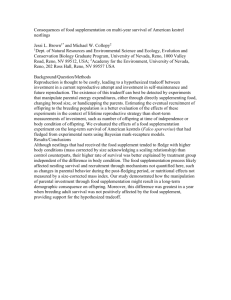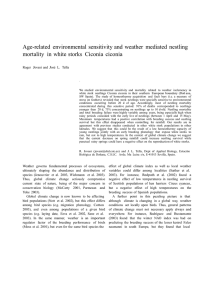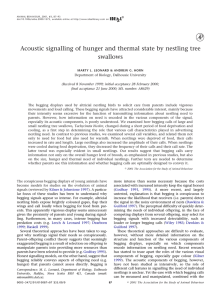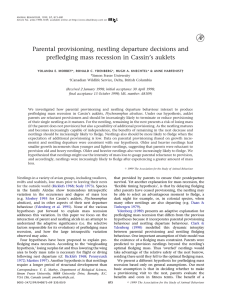ADULT AND NESTLING BAND RETURNS AND LONG-TERM SURVIVAL MONITORING OF... INHABITING THE TITTABAWASSEE RIVER BASIN
advertisement
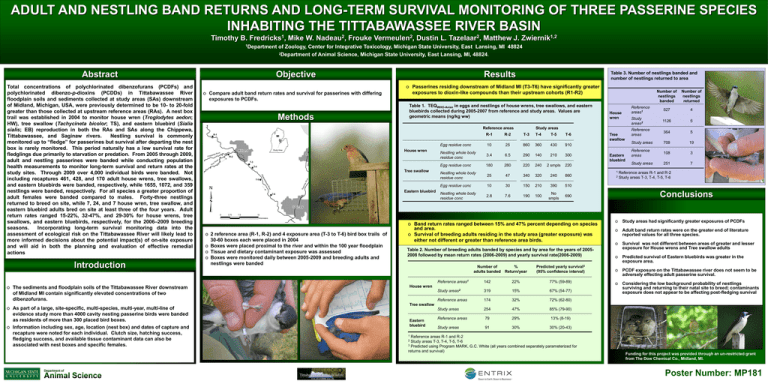
ADULT AND NESTLING BAND RETURNS AND LONG-TERM SURVIVAL MONITORING OF THREE PASSERINE SPECIES INHABITING THE TITTABAWASSEE RIVER BASIN Timothy B. Fredricks1, Mike W. Nadeau2, Frouke Vermeulen2, Dustin L. Tazelaar2, Matthew J. Zwiernik1,2 1Department Abstract Total concentrations of polychlorinated dibenzofurans (PCDFs) and polychlorinated dibenzo-p-dioxins (PCDDs) in Tittabawassee River floodplain soils and sediments collected at study areas (SAs) downstream of Midland, Michigan, USA, were previously determined to be 10- to 20-fold greater than those collected at upstream reference areas (RAs). A nest box trail was established in 2004 to monitor house wren (Troglodytes aedon; HW), tree swallow (Tachycineta bicolor; TS), and eastern bluebird (Sialia sialis; EB) reproduction in both the RAs and SAs along the Chippewa, Tittabawassee, and Saginaw rivers. Nestling survival is commonly monitored up to “fledge” for passerines but survival after departing the nest box is rarely monitored. This period naturally has a low survival rate for fledglings due primarily to starvation or predation. From 2005 through 2009, adult and nestling passerines were banded while conducting population health measurements to monitor long-term survival and return rates at the study sites. Through 2009 over 4,000 individual birds were banded. Not including recaptures 461, 428, and 170 adult house wrens, tree swallows, and eastern bluebirds were banded, respectively, while 1655, 1072, and 359 nestlings were banded, respectively. For all species a greater proportion of adult females were banded compared to males. Forty-three nestlings returned to breed on site, while 7, 24, and 7 house wren, tree swallow, and eastern bluebird adults bred on site at least three of the four years. Adult return rates ranged 15-22%, 32-47%, and 29-30% for house wrens, tree swallows, and eastern bluebirds, respectively, for the 2006–2009 breeding seasons. Incorporating long-term survival monitoring data into the assessment of ecological risk on the Tittabawassee River will likely lead to more informed decisions about the potential impact(s) of on-site exposure and will aid in both the planning and evaluation of effective remedial actions. Introduction o The sediments and floodplain soils of the Tittabawassee River downstream of Midland MI contain significantly elevated concentrations of two dibenzofurans. o As part of a large, site-specific, multi-species, multi-year, multi-line of evidence study more than 4000 cavity nesting passerine birds were banded as residents of more than 300 placed bird boxes. o Information including sex, age, location (nest box) and dates of capture and recapture were noted for each individual. Clutch size, hatching success, fledging success, and available tissue contaminant data can also be associated with nest boxes and specific females. of Zoology, Center for Integrative Toxicology, Michigan State University, East Lansing, MI 48824 2Department of Animal Science, Michigan State University, East Lansing, MI, 48824. Objective o Compare adult band return rates and survival for passerines with differing exposures to PCDFs. Methods Results Table 3. Number of nestlings banded and number of nestlings returned to area o Passerines residing downstream of Midland MI (T3-T6) have significantly greater exposures to dioxin-like compounds than their upstream cohorts (R1-R2) Table 1. TEQWHO-Avian in eggs and nestlings of house wrens, tree swallows, and eastern bluebirds collected during 2005-2007 from reference and study areas. Values are geometric means (ng/kg ww) Results Reference areas Egg residue conc House wren Tree swallow Eastern bluebird o 2 reference area (R-1, R-2) and 4 exposure area (T-3 to T-6) bird box trails of 30-60 boxes each were placed in 2004 o Boxes were placed proximal to the river and within the 100 year floodplain o Tissue and dietary contaminant exposure was assessed o Boxes were monitored daily between 2005-2009 and breeding adults and nestlings were banded House wren Study areas R-1 R-2 T-3 T-4 T-5 T-6 10 25 860 360 430 910 Nestling whole body residue conc 3.4 6.5 290 140 210 300 Egg residue conc 180 280 220 240 2 smpls 220 Tree swallow Eastern bluebird Number of nestlings banded Number of nestlings returned Reference areas1 527 4 Study areas2 1126 5 Reference areas 364 5 Study areas 708 19 Reference areas 108 3 Study areas 251 7 1 Nestling whole body residue conc 25 47 340 320 240 860 Egg residue conc 10 30 150 210 390 510 Nestling whole body residue conc 2.8 7.6 190 100 No smpls 690 o Band return rates ranged between 15% and 47% percent depending on species and area. o Survival of breeding adults residing in the study area (greater exposure) was either not different or greater than reference area birds. Table 2. Number of breeding adults banded by species and by area for the years of 20052008 followed by mean return rates (2006-2009) and yearly survival rate(2006-2009) Reference areas R-1 and R-2 2 Study areas T-3, T-4, T-5, T-6 Conclusions o Study areas had significantly greater exposures of PCDFs o Adult band return rates were on the greater end of literature reported values for all three species. o Survival was not different between areas of greater and lesser exposure for House wrens and Tree swallow adults o Predicted survival of Eastern bluebirds was greater in the exposure area. Number of adults banded % Return/year Predicted yearly survival3 (95% confidence interval) o PCDF exposure on the Tittabawassee river does not seem to be adversely effecting adult passerine survival. Reference areas1 142 22% 77% (59-89) o Study areas2 319 15% 67% (54-77) Considering the low background probability of nestlings surviving and returning to their natal site to breed; contaminants exposure does not appear to be affecting post-fledging survival Reference areas 174 32% 72% (62-80) Study areas 254 47% 85% (79-90) Reference areas 79 29% 13% (8-19) Study areas 91 30% 30% (20-43) House wren Tree swallow Eastern bluebird 1 Reference areas R-1 and R-2 2 Study areas T-3, T-4, T-5, T-6 3 Predicted using Program MARK, G.C. White (all years combined separately parameterized for returns and survival) Funding for this project was provided through an un-restricted grant from The Dow Chemical Co., Midland, MI.






